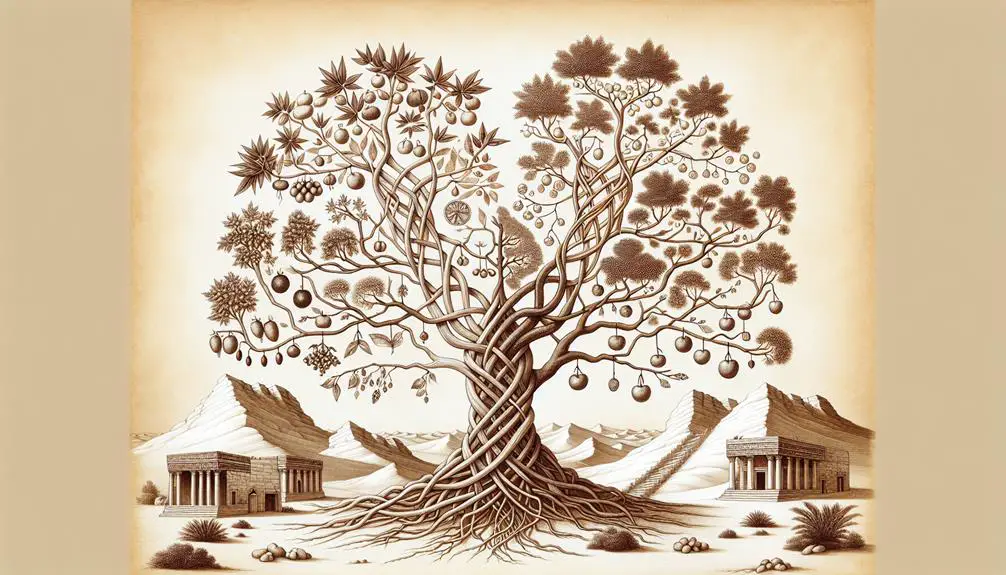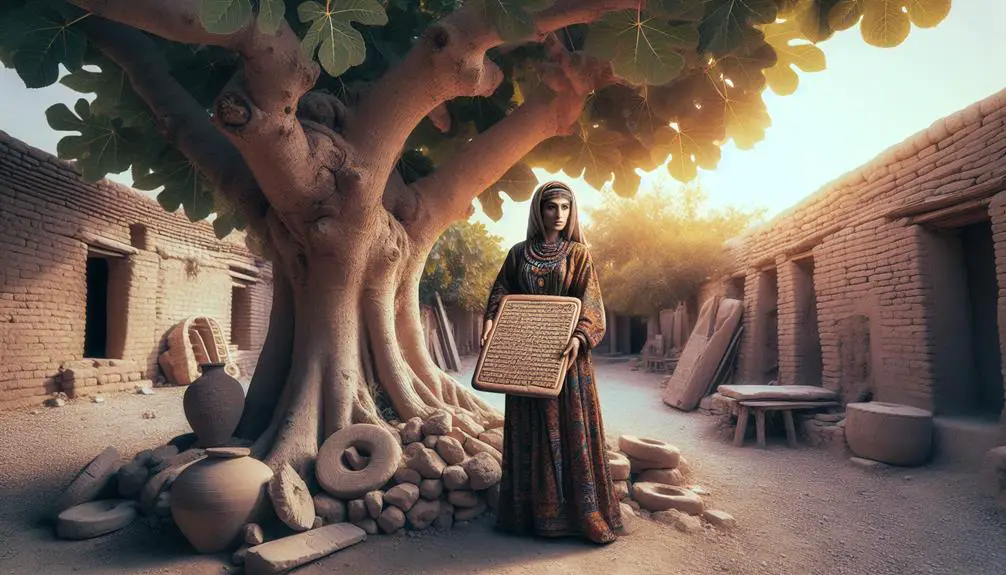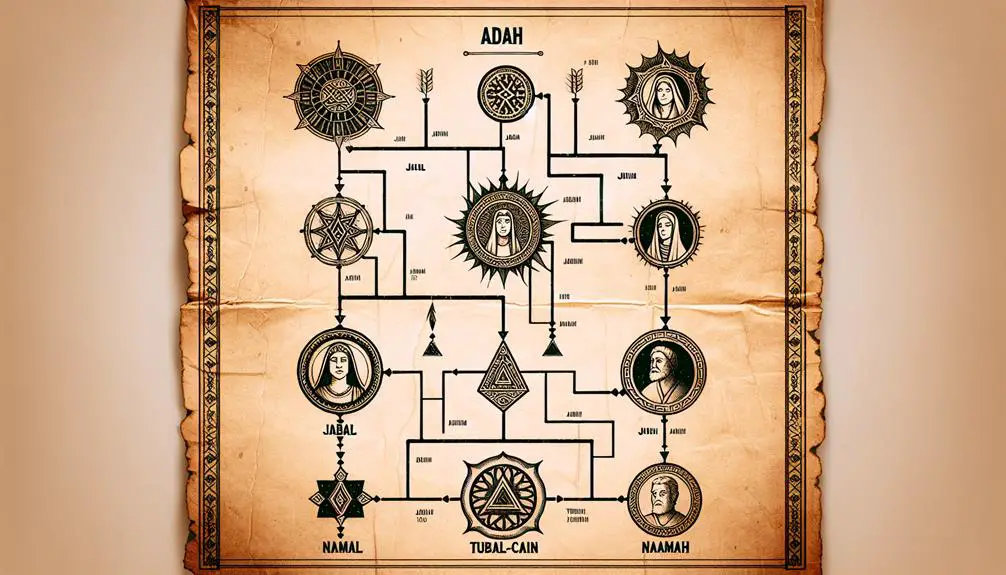Step into the biblical times as we explore the enigmatic figure of Adah, uncovering her role and connections in the ancient scriptures.

Who Is Adah in the Bible
You've likely heard various theories about biblical figures, but have you ever pondered who Adah truly is in the Bible?
As one of the less-discussed characters, Adah's identity and her familial connections offer a rich tapestry of insights into biblical narratives and genealogies. Her name alone carries significance, nestled within the historical context of her era.
By exploring Adah's legacy, you'll uncover layers of biblical history that remain overlooked by many. What could her story reveal about the times she lived in and the people she connected with?
Let's embark on this journey to uncover the hidden gems within Adah's story, unearthing the significance of her role in biblical history and what it means for our understanding of the text.
Key Takeaways
- Adah, one of Lamech's wives, played essential roles in biblical society, including household management and child-rearing.
- She was part of a notable lineage, mother to Jabal and Jubal, and related to Tubal-cain and Naamah.
- Her name, meaning beauty or ornament in Hebrew, reflects societal views on women's roles and attributes.
- Adah's story offers insights into gender dynamics and the cultural significance of women in biblical narratives.
The Identity of Adah

Adah, a figure mentioned in the Hebrew Bible, holds a multifaceted role that merits a closer examination to understand her identity within the biblical narrative. You'll find that her identity, shaped by her occupations and marital status, offers a window into the societal norms and values of the time.
Firstly, Adah's marital status is a significant aspect of her identity. She's known as one of the wives of Lamech, a descendant of Cain, which places her within a specific socio-religious context. This marital connection not only defines her social standing but also her role within her family structure and broader society. Being a wife during this period often meant adherence to certain expectations and duties, which would have influenced Adah's daily life and interactions.
Turning to Adah's occupations, the biblical text doesn't provide explicit details. However, extrapolating from the historical and cultural setting of the time, it's reasonable to assume that her roles would have encompassed domestic responsibilities typical of women in ancient societies. These could have included household management, food preparation, and child-rearing. Such occupations were crucial for the sustenance and continuity of family and community life, highlighting the importance of women's work, albeit often undervalued in historical records.
In analyzing Adah's identity through the lenses of her occupations and marital status, you uncover the layered complexity of her character. She embodies the essential, albeit often overlooked, roles women played in biblical times, serving as a testament to their integral contribution to society's fabric.
Adah's Familial Connections

Exploring the familial connections of Adah reveals a complex network of relationships that deeply influenced her status and role within both her immediate family and the wider community. Her genealogical importance and marital dynamics offer insights into the societal structures of her time.
Relationship |
Individual(s) |
|---|---|
Husband |
Lamech |
Sons |
Jabal and Jubal |
Brother-in-law |
Tubal-cain |
Nephew |
Naamah |
Adah's marriage to Lamech, a descendant of Cain, positioned her within a notable lineage, highlighting her genealogical importance. This union was not merely a personal alliance but a strategic one, reinforcing the social and economic standing of her family. Lamech's polygamy, with Adah as one of his wives, introduces complexities into the marital dynamics, suggesting a competitive environment within the household.
Her sons, Jabal and Jubal, contributed significantly to the cultural advancements of their society, with Jabal being the father of those who dwell in tents and have livestock and Jubal the father of all those who play the lyre and pipe. These contributions further elevated Adah's status, showcasing the impact of her offspring on societal evolution.
Adah's familial connections, therefore, are not merely a backdrop but a foreground that highlights the intertwining of personal relationships with societal development. The examination of these connections provides a nuanced understanding of her role and the broader implications of her family's contributions to their community.
Significance of Adah's Name

You must consider the layers of meaning behind Adah's name, which holds significant cultural and historical weight within biblical contexts. Its interpretation not only sheds light on her character but also on the societal norms and values of the time.
Analyzing the cultural impact of her name provides deeper insight into the narrative roles and the broader biblical landscape.
Meaning Behind Adah
The name Adah carries profound symbolic significance in Biblical narratives, reflecting themes of beauty and adornment. In understanding Adah's symbolism, one must consider:
- Adah's etymological roots: The name is thought to derive from Hebrew, symbolizing ornament or beauty, positioning Adah as a figure of aesthetic and moral value in the scriptural context.
- Interpretative variations: Scholars and theologians have debated the exact nature of Adah's significance, with some viewing her as a symbol of transient beauty and others as an emblem of grace and favor in a patriarchal society.
- Theological implications: Adah's narrative serves as a lens through which the cultural and spiritual values of the time are examined, offering insights into the ancient world's perception of women and their roles.
Cultural Impact of Name
Having considered Adah's etymological roots and theological significance, it's crucial to examine the broader cultural impact of her name on both historical and contemporary contexts. The name variations and linguistic origins of Adah reveal a tapestry of cultural assimilation and adaptation. Its Semitic roots underscore a rich heritage, influencing various cultures and languages.
These variations reflect not just the evolution of language, but also the migration and intermingling of peoples and traditions. Consequently, Adah's name serves as a microcosm of cultural exchange, embodying the fluidity of identity across time and geography. It's a testament to how names carry more than personal identity; they encapsulate a confluence of historical, linguistic, and cultural narratives.
Historical Context of Her Era

Several historical records from her era suggest that Adah lived during a period marked by significant social and religious transformations. The era's geopolitics and social norms were in a state of flux, influencing the lives of those within and around Adah's community. This time was characterized by:
- Shifts in Geopolitical Power: The landscape of power was continually changing, with emerging kingdoms and fading empires. This dynamic geopolitical environment impacted trade, alliances, and cultural exchanges across regions.
- Evolving Social Norms: Social norms weren't static during Adah's lifetime. The roles and statuses of individuals could shift, influenced by broader societal changes. These norms dictated everything from familial structures to religious practices, heavily influencing daily life.
- Religious Transformations: This period witnessed significant religious transformations. New religious ideas emerged, and existing beliefs adapted to changing circumstances. This evolution in religious thought played a crucial role in shaping the community's worldview and moral code.
Analyzing the historical context of Adah's era provides valuable insights into the challenges and opportunities she might've encountered. The era's geopolitics, evolving social norms, and religious transformations collectively shaped the environment in which Adah and her contemporaries lived. Understanding these factors helps to paint a fuller picture of her life and the historical period she inhabited, beyond the sparse details available in biblical genealogies.
Adah in Biblical Genealogies

Reflecting on the historical context of Adah's era, it's crucial to examine her mention in biblical genealogies to understand her role and significance within these narratives. The Bible mentions Adah in the context of early human history, positioning her as a key figure in the lineage of certain tribes and peoples. Her inclusion in these genealogies isn't merely a testament to her existence but highlights the ancestral implications and connections she represents within the broader biblical story.
Adah's name surfaces amidst complex genealogical records, which are essential for tracing the lineage and heritage of biblical figures. These genealogies serve not only as historical records but also as a means to understand the relational dynamics and societal structures of ancient times. Adah's presence in these lists underlines her importance in the lineage she belongs to, shedding light on the roles women played in maintaining and transmitting cultural and familial identities.
However, the examination of her mention also reveals genealogical discrepancies that prompt deeper scholarly inquiry. These discrepancies may arise from variations in textual transmission or interpretative differences, necessitating a careful analysis to reconcile them. Such examination is vital for accurately understanding the ancestral implications of her lineage and its impact on subsequent generations.
Adah's mention in biblical genealogies, therefore, isn't just a note on a family tree but a doorway into understanding the intricate web of relationships, societal norms, and cultural heritage of the time. By analyzing her place within these genealogies, you gain insights into the significance of lineage and heritage in biblical narratives and the pivotal role women like Adah played in shaping the ancestral story of the biblical world.
Reflections on Adah's Legacy

You must consider Adah's role in biblical narratives to understand her enduring legacy and its relevance today.
Her story offers insights into the evolution of feminine influence in religious texts, guiding modern interpretations.
Evaluating her contributions reveals how perceptions of women in ancient contexts have expanded over time.
Adah's Biblical Role
In exploring Adah's biblical role, it's crucial to recognize her as one of the first women mentioned in the genealogies of Genesis, thereby setting a foundational precedent for female representation in biblical narratives. Adah's portrayal and the marital dynamics of her time reveal much about the societal norms and values of ancient cultures.
- Adah's Representation: She embodies the complexities of womanhood in early biblical texts, highlighting the roles and expectations of women.
- Marital Dynamics: Her marriage sheds light on the polygamous practices of the era and their impact on women's social standing.
- Cultural Significance: Adah's story offers insights into the genealogical importance and the perpetuation of lineage in biblical times, reflecting the broader cultural and religious significance of her role.
Legacy's Modern Interpretation
Adah's legacy, when examined through a modern lens, reveals a nuanced understanding of her role and its implications for contemporary discussions on gender and scripture.
Modern interpretations of her story bring to light the complexities of gender perspectives within biblical narratives, offering a richer, more textured view of ancient texts.
These interpretations challenge traditional readings and encourage a reevaluation of women's roles in religious history.
By scrutinizing Adah's story through the prism of gender perspectives, scholars and lay readers alike uncover layers of meaning that were previously obscured or unconsidered.
This approach not only enriches our understanding of Adah herself but also contributes to broader conversations about gender dynamics in sacred texts, highlighting the evolving nature of scriptural interpretation in the face of changing societal norms.
Feminine Influence Expanded
Reflecting on Adah's legacy allows for a broader exploration of feminine influence in biblical narratives, underscoring how these stories shape our understanding of gender roles. Adah's story contributes to the intricate tapestry of gender dynamics and religious roles depicted in these ancient texts.
- Gender Dynamics – Adah's narrative illustrates the complexity of women's roles and their impact on cultural and religious practices.
- Religious Roles – Her story offers insights into the participation of women in religious life, challenging traditional interpretations of female subservience.
- Cultural Influence – Adah serves as a lens through which the evolving perceptions of women's contributions to society can be examined, highlighting the intersection between gender, culture, and religion.
This analysis reinforces the significance of feminine perspectives in shaping historical and spiritual discourses.
Frequently Asked Questions
How Do Modern Interpretations of Adah's Story Vary Across Different Cultures and Religions?
You'll find that modern interpretations of Adah's story vary widely due to cultural symbolism and religious reinterpretations. Analyzing these narratives, you'll notice scholars often highlight how different cultures and religions adapt her story to reflect their own values and beliefs.
This scholarly exploration reveals a rich tapestry of meanings, demonstrating how Adah's tale is reshaped by diverse perspectives, ensuring her story resonates across various contexts in unique and insightful ways.
What Are the Archaeological Findings, if Any, That Have Been Linked to Adah or Her Era?
You're diving into a time machine, exploring ancient lands without a GPS.
Archaeological findings linked to Adah's era, though scarce, shed light on her story. Excavation methods have evolved, enabling a deeper understanding of the historical context.
Scholars meticulously sift through layers of history, piecing together artifacts that offer glimpses into her time. However, direct links to Adah remain elusive, challenging researchers to decode the past with the fragments unearthed.
How Has Adah's Story Influenced Contemporary Art, Literature, or Music?
Adah's story has significantly influenced contemporary art, literature, and music.
You'll find Adah inspired paintings that capture her essence, using vivid imagery to tell her tale.
Similarly, Adah themed novels explore her narrative in depth, offering new interpretations and insights.
These creative works not only celebrate her story but also invite you to consider its impact on modern culture.
Through these artistic expressions, Adah's legacy continues to inspire and resonate with many.
Are There Any Notable Discrepancies in Adah's Story When Comparing the Accounts in Jewish, Christian, and Islamic Traditions?
When you delve into the narratives across Jewish, Christian, and Islamic traditions, you'll notice discrepancies that beckon a deeper examination. These variations, especially concerning genealogical significance and translation discrepancies, highlight the complex tapestry of religious texts.
They don't just tell a story; they offer a kaleidoscope of interpretations that challenge and enrich your understanding. Analyzing these differences requires a scholarly, objective lens, focusing on both the minutiae and the broader implications.
How Do Feminist Theologians View and Interpret the Character of Adah in the Context of Biblical Narratives?
You'll find that feminist theologians often view Adah as a symbol of empowerment within biblical narratives. They analyze her story through the lens of gender dynamics, highlighting how she navigates her roles and relationships.
This perspective sheds light on Adah's empowerment, challenging traditional interpretations and offering a nuanced understanding of her character. By doing so, scholars aim to reframe the narrative, emphasizing women's agency in ancient texts.
Conclusion
In conclusion, like a single thread intricately woven into a vast tapestry, Adah's story contributes to the rich fabric of biblical history. Despite the brevity of her mention, her role within her family and the significance of her name offer a glimpse into the societal and familial structures of her time.
Adah's presence in biblical genealogies serves as a reminder of the importance of each individual's contribution to the collective narrative of humanity, no matter how briefly they may appear in the historical record.



Sign up